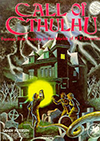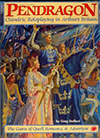100 Best Games - RuneQuest
Just click on the game cover to read the related essay

RuneQuest - Jennell Jaquays
Key Designers: Steve Perrin, Ray Turney, Steve Henderson, Warren James, Greg Stafford
Chaosium (first edition, 1978)
During the summer of 1978, the hobby gaming world was ready to embrace new ideas that would change the way we roleplayed. A set of game rules housed in a red and brown cover debuted at the Origins game convention in Ann Arbor, Michigan, and heralded the coming of a true second generation of roleplaying designs. The first generation of popular fantasy games — including Dungeons & Dragons, Tunnels & Trolls, and Chivalry & Sorcery — all stayed close to home, as far as the type of experience that they offered. Most took place in an ambiguously generic westernized fantasy world drawn from a host of literary sources, such as The Lord of the Rings, Howard’s Conan cycle, Fritz Leiber’s tales of Fafhrd and the Gray Mouser, and Arthurian lore, with a sprinkling of Greek and Norse mythology to provide fantastic beasties. They restricted the player to a narrowly defined role as a wizard, warrior, thief, or martial cleric. Few, if any, had a unified structure for handling both gameplay and character advancement.
From these foundational sources, roleplayers created their worlds of fantasy and adventure — worlds that would invariably resemble one another as subtle variations on the same pseudo-medieval melange. Wizards cast spells and ran around in robes. Warriors bashed monsters and got to wear all the cool hardware. Thieves snuck about and stole things. Clerics hit things less effectively than warriors, but did so with the blessings of their ambiguous, spell-granting deities. Everyone had a defined role and stuck to it. Player advancement was defined by accumulating experience to advance upward through arbitrary levels of power.
RuneQuest changed all that.
Breaking away from generic fantasy, the game transported players to the vibrant setting of Dragon Pass in Greg Stafford’s Glorantha, an archaic world grown from the myths and legends of Bronze Age peoples. Inside the amateurish single rules volume was a well-defined mythology of gods and heroes whose influence is tightly woven into the fabric of the people’s lives. RuneQuest was not the first RPG to spring out of an established fictional world. M.A.R. Barker’s Empires of the Petal Throne (EPT), based in his deeply detailed world of Tékumel, had broken that ground in 1975. Yet RuneQuest made the premise work, made it popular, and drew players into the world of Glorantha in a way that the original EPT, based on simplified early Dungeons & Dragons rules, never would.
For those of us discovering it for the first time that summer, Dragon Pass and its inhabitants were like nothing seen before. Instead of unrelated groups of monsters lurking amidst ambiguous hex-shaped geography or dwelling in convenient 10' by 10' rooms beneath the ground, we discovered a living environment populated by real-seeming peoples of many cultures and races, not all of them human. Monsters had as much reason for existing as the humans who shared their world.
While new to roleplayers, the world of Glorantha had previously appeared in White Bear & Red Moon and Nomad Gods, a pair of board games designed by Greg Stafford and produced by Chaosium. In those games, the wars between a powerful empire and the barbarian tribes they sought to subjugate defined the peoples, places, and creatures of the world. It was a rich resource upon which to build a roleplaying game setting.
Glorantha brings to mind what life might have been like in ancient Greece or Mesopotamia, where every event had supernatural significance. It is a world where divine beings need the worship of followers as much or even more than those followers need the abilities gained from their gods. It is a world permeated with magic on all levels. One’s place and influence are defined not by arbitrary power levels, but by choices of allegiance and service. To succeed in the world of Glorantha, a player’s character has to become enmeshed within the world’s complex society and structure.
In the world of RuneQuest, heroic adventurers battle frightening foes to preserve their Bronze Age way of life and bring glory and honor upon clan, tribe, or temple. Heroes fight nasty (and I mean vile) goat-headed broos, whose diseased touch poisons the world; run in fear from pumpkin-headed jack-o-bears; avoid the gloppy advances of amorphic gorps; dodge the lunges of spring-tailed stake snakes; and bash zombies to flinders to defeat them.
RuneQuest has no player classes (such as wizard, fighter, thief, and the like). No mages who can’t fight or wear armor. No warriors limited to just hitting things and absorbing damage. Everyone can try their hands at picking a pocket or a lock. And priests are something you study to become, not a career you choose at the outset of a campaign. Player choices regarding weapons, armor, skills, and magic seem more meaningful because they define who your character is and, more importantly, who he or she will become.
The arms and armor Gloranthan heroes use have more to do with Homer’s Odyssey than they do with medieval romances. Bronze is the metal of choice, for those rich enough to afford metal. Iron can only be used by powerful Rune Lords and Rune Priests, who gain it through service to their deities. Everyone has access to spirit, or battle magics, but powerful Rune magic is gained only by permanently sacrificing personal power to one’s deity.
The RuneQuest rules seek to simulate a more realistic type of combat within a simple structure. All player abilities use a unified, skill-based system. Success with a weapon attack or a skill can be determined by a single percentile die roll. Weapon choice matters. Stabbing with a two-handed spear means you have a chance to hit a sword-wielding foe long before he hits you. Armor choice matters, because the hit location mechanic actually makes wearing a helmet relevant to gameplay, not just a fashion choice. Whether one is fighting a foe with a sword, jumping a chasm, or trying to talk a monster out of eating a pal, the same mechanics applies to every action. And if a character succeeds at something, she gets a chance to improve that skill.
In time, RuneQuest would be updated to a second and third edition (moving away from its strictly Gloranthan roots). Yet the game had already left its stamp. Its unified combat and skill system would become the foundation for Chaosium’s generic Basic Role-Playing rules, upon which Sandy Petersen would build his immensely popular Call of Cthulhu game, among others. The idea of generic rules would later become the motivation for enduring systems like Steve Jackson Games’ GURPS and Wizards of the Coast’s pervasive d20 System rules.
After RuneQuest and Glorantha, detailed fantasy worlds would become the norm, not the exception. Dragon Pass paved the way for TSR’s Faerûn, better known as the Forgotten Realms, and Krynn, setting for the Dragonlance saga. But few would ever achieve the elegant but approachable rules complexity of the original RuneQuest or instill a fervent loyalty in fans that would span decades.
In the muggy heat of that Michigan summer, RuneQuest changed the way we gamed.
Jennell Jaquays pioneered pre-made RPG scenarios in her D&D fanzine The Dungeoneer in 1976 and was well known for her enduring game adventures Dark Tower and Griffin Mountain. She assembled one of the first art and design studios for video game development at Coleco to make ColecoVision games. After working as an illustrator, designer, author, and editor, she returned to computer games in 1997 as a level designer for id Software and later as an artist for Microsoft/Ensemble Studios. She helped set up The Guildhall at SMU (Southern Methodist University), the foremost school for digital game development. Most recently she has returned to authoring and producing adventures and support material for tabletop roleplaying games under her own publishing brand, Fifth Wall Games and Miniatures.
Essay © copyright 2007, 2019 Jennell Jaquays. Originally published in Hobby Games: The 100 Best, edited by James Lowder, Green Ronin, 2007. Reprinted by permission of the author.





